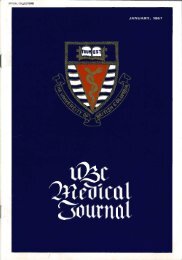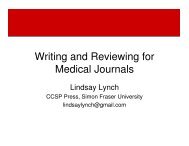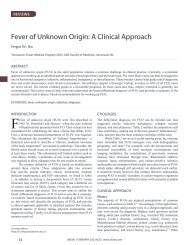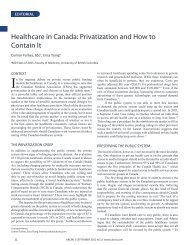Download full PDF - UBC Medical Journal
Download full PDF - UBC Medical Journal
Download full PDF - UBC Medical Journal
You also want an ePaper? Increase the reach of your titles
YUMPU automatically turns print PDFs into web optimized ePapers that Google loves.
YEAR 3<br />
While undergoing functional magnetic resonance imaging, 26<br />
schizophrenia patients and 26 control subjects completed 90<br />
association tasks (i.e., they were provided a cue word, and were<br />
required to choose the more strongly associated of two companion<br />
words). Following scanning, subjects were asked to free-recall and<br />
cue-recall the word pairs viewed in the scanner. Using constrained<br />
principal component analysis with a finite impulse response basis<br />
set, three statistically significant components of neural activity<br />
emerged. Component 1 involved activity in left inferior parietal<br />
lobe, left superior temporal gyrus, bilateral visual cortices and<br />
dorsal anterior cingulate cortex (dACC). Component 2 showed<br />
activity in dACC/supplementary motor area, visual cortices,<br />
and left premotor cortex. Component 3 showed deactivation in<br />
medial prefrontal cortices and posterior cingulate/precuneus. For<br />
all components, encoding words that were later not recalled was<br />
associated with higher activation or deactivation than encoding<br />
free- or cue-recalled words; and encoding cue-recalled words<br />
showed higher activation or deactivation than encoding freerecalled<br />
words. For components 1 and 3, schizophrenia patients<br />
exhibited less activation or deactivation than control subjects<br />
when encoding cue-recalled words (p < .05). Greater activity<br />
when encoding non-recalled words, or those only recalled when<br />
cued, may reflect increased difficulty or interference at the<br />
encoding stage. The differences in activity of these components<br />
observed in schizophrenia patients may help elucidate the<br />
variations in associative memory function thought to underlie<br />
many characteristic features of this disease.<br />
Are the Eyes the Windows to the<br />
Human Soul Gaze Direction Study and<br />
its Effects on Attentional Orienting and<br />
Crossmodal Target Responses<br />
Jennifer Quan, Salvador Soto-Faraco, John McDonald,<br />
Alan Kingstone<br />
Department of Psychology, University of British Columbia<br />
Objective: Human beings are highly social creatures who use<br />
verbal and body language to communicate. Eye contact is a<br />
powerful means of communication. The following 7 experiments<br />
attempts to determine the degree in which the eyes illicit reflexive<br />
responses in human senses from visual, auditory, and tactile<br />
responses; and hopes to answer the age-old question of whether<br />
the eyes are the windows to the soul.<br />
Methodology: A schematic face was shown on a computer screen,<br />
with eyes that were either spatially informative (looked towards the<br />
target) or spatially uninformative (looked in the opposite direction<br />
of the target). Participants were instructed to press either the left<br />
or right button depending on where they thought the visual target<br />
appeared. To measure the effect of eye-gaze on auditory attention,<br />
sound, rather than a visual target, was used as the target. Again,<br />
the participants were asked to input where they thought the sound<br />
originated (left or right). To measure tactile response, the schematic<br />
face was replaced by 4 dots that flashed on the left or right of the<br />
screen. Participants were again asked to input on the response pad<br />
where they thought the sound originated (left or right). Response<br />
times and accuracy were measured for all the experiments.<br />
Results: Eye-gaze cuing produced a shift in visual attention, as<br />
supported by faster response times in the valid trials (when the<br />
eyes pointed towards the visual cues) than in the invalid trials<br />
(when the eyes did not point towards the visual cues) with a<br />
p










